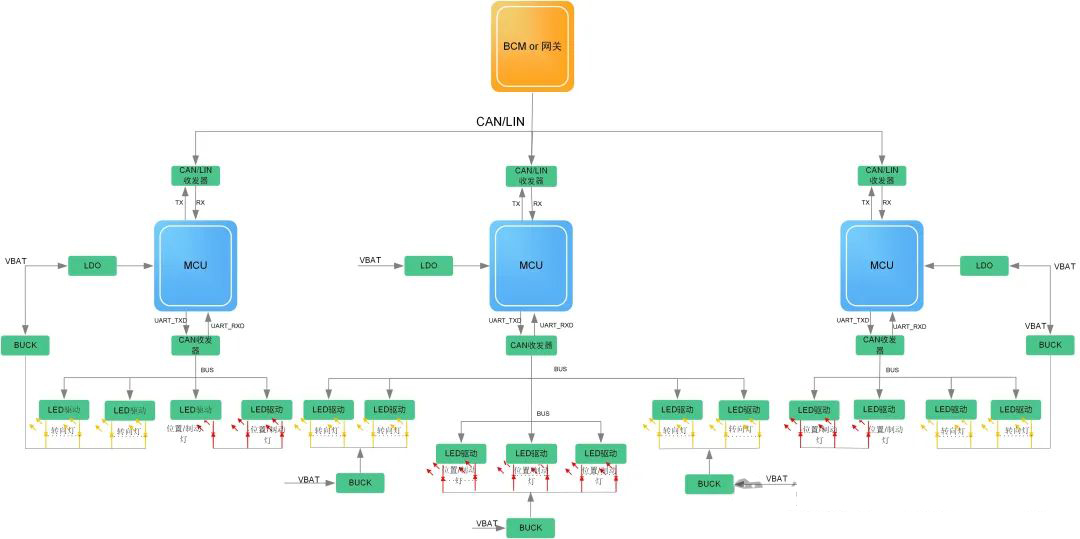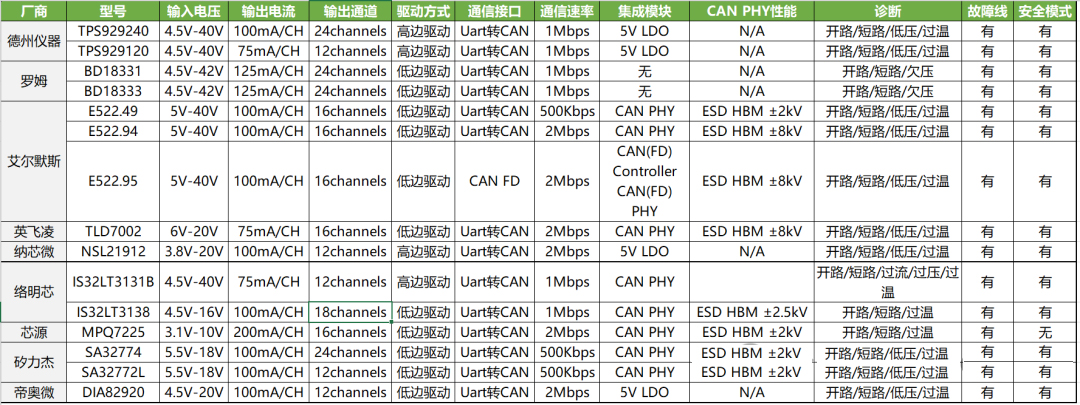

-
 English
English
-
 中文
中文
-
 한국인
한국인
-
 Русский
Русский
-
 Deutsch
Deutsch


 English
English
 中文
中文
 한국인
한국인
 Русский
Русский
 Deutsch
Deutsch
In the past two years, the domestic car gauge chip is more hot, the author combined with their own understanding, a detailed introduction of the commonly used through the taillight program of imported and domestic chips.
Part.1 CHIP OVERVIEW

At present, the common through taillight scheme
An MCU is used on the left and right fixed sides to control the turn signal, position light and brake light on the fixed side. At the same time, in order to reduce costs, many automakers will reuse the position lights and brake lights, and distinguish the functions of different currents by configuring LED drivers.
The mobile side generally uses an MCU to control the turn signal, penetration position light and brake light.
The three MCUS synchronize the lamp effect and communicate with other ECU nodes in the body through CAN bus or LIN bus.
The chip is included in the penetration taillight solution
The main control chip, generally using M0 core or M4 core MCU, mainly depends on the complexity of the software.
Power chip, generally use BUCK type DCDC and 40V voltage resistant LDO.
Driver chip, generally use 12/16/24 channel linear constant current chip.
Communication chip, generally CAN, LIN transceiver.
Part.2 Main control chip
The main control chip requirements of the taillight are not high, the MCU of the M0 core can be used, and the peripherals are required.
One way CAN, one way LIn, one way UART, 1 way ADC, the storage requires 128K Flash.
If the car manufacturer needs information security or functional safety, the corresponding MCU needs to have encryption modules and functional safety certification.
If the auto manufacturer requires the AutoSAR platform, the demand for Flash will be much larger, requiring 512K to 1MB of Flash, depending on the actual use of AutoSAR basic software needs to occupy how much Flash.

List of common MCU resources
Taillights in the car gauge MCU is the most used
NXP's S32K1 series, the first two years because of supply constraints, customers have concentrated on the main control model S32K144 (100pin). But from the point of view of matching requirements, the S32K116 can meet it.
In the taillight scheme, the domestic car gauge MCU is used more
Zhixin, Jiefa, Jiefa's AC78013 was the earliest mass production, but the supply was tight in the first two years, and many customers replaced Zhixin's Z20K11x series. Recently, some customers are using Yuntu's YTM32B1L series, and Yuntu's code generation tools, software libraries and other supporting ecological chains are relatively more complete.
The car gauge MCU in the southwest of the country before the use of more customers, East China is also a small number of customers in the use of lights. Beijing Zhaoyi's industrial-grade MCU is the domestic leader, but the layout of the car-gauge MCU is late, resulting in the use of GD32A503 customers are not too many.
There is also a customer who uses more KF32A1xx series of Xinwang Micro, but because its core is not ARM core, many customers have concerns about his subsequent roadmap
Part.3 Power chip
Power chip needed in taillight scheme
The BUCK type DCDC(BUCK) is used to convert the 12V of the body battery to about 8V, which is used to power the LED lamp beads and LED drivers.
The LDO is used to convert the 12V of the body battery to around 5V to power the MCU and CAN transceiver.
3.1 BUCK Chip

Common BUCK parameter list
BUCK chips are still dominated by imports, and domestic use is not much.
TI has always been a leader in the field of DCDC, most customers have used TI's power chip, and now many automotive customers have turned to TI direct customers, the price and service support will be better. LM61460 and LM62440 now belong to the new materials mainly promoted by TI. The author has seen that some large-volume customers of headlights will choose these materials in the new scheme design.
MPS MPQ442x series has been used very much in vehicle navigation customers before, MPQ4436 because of EMC performance is relatively good, and the highest output can reach 6A
MAX20004 and MAX20006 are used more in the traditional headlight scheme, and many customers are also using the through-line taillight scheme.
3.2 LDO chip
Customers are currently seeing LDO models used in taillight schemes. Imports: TI, ROM, MPS. Domestic: Nano micro, Siripu, Hillhouse core.

List of common LDO parameters
LDO basically uses 150mA to 300mA, mostly for SOT223 and SOP8 and other common packages, domestic car regulations LDO and imported packages are basically the same, most of them are pin2pin.
Part.4 Driver chip
In the penetration taillight scheme, the most used chip is the multi-channel LED driver;
In the early days, when the technology of UART to CAN was not mature, customers would choose the LED driver of SPI or IIC interface. Now, because the interface technology of UART to CAN is mature, and there are many brands to choose from, basically, multi-channel LED drivers using UART to CAN interface are used.
The following table shows the overall parameter comparison:

At present, there are four LED driver chips commonly used in the market for UART to CAN interface, respectively TI, ELMOS, ROM and Nanomicro.
At present, the most used by TI customers is TPS92910, which is a 40V voltage withstand, 12 output channels (up to 75mA per channel), and supports high side drive mode of linear constant current LED driver with short circuit diagnosis. At present, with the increase in the use of LED through the taillight, as well as the rise of ISD and other programs, the 12-channel sometimes can not meet the demand, and the main model is now the 24-channel TPS929240.
ELMOS customers currently use the most is E522.49, compared to TPS92910 more channels, a higher single-channel current, the internal integration of a tailored version of the CAN transceiver. If the connection between the board of the MCU and the LED driver in the customer's use scenario is more than 50cm, the E522.94 is recommended, and the complete CAN FD transceiver is integrated inside. If customers need to support the full CAN FD protocol (mainly the data link layer), they can consider using E522.95.
At present, the most used by Rohm customers is BD18333, compared with the previous generation BD18331, improve the short-circuit diagnosis function. Compared with TPS929120 and TPS929240, the number of channels is more, supporting 24 channel output, but in the customer design, the length of the PCB line and the capacitor placement of the output channel are relatively high requirements.
At present, the multi-channel LED driver produced by Nano Micro is NSL21912, which is hardware and software compatible with TI's TPS929120. At the same time, the problem that TPS929120 appears slightly bright when the PWM duty cycle is 0 and the channel is enabled is turned on is fixed. However, NSL21912 compared to TPS92910, the voltage is only 20V, there are not many problems in the use of BUCK chip taillight scheme, if the cost is lower, LED power is not high grille lamp scheme (general LED drive directly connected to the body battery) will be at risk.
Part.5 Communication chip
The communication chips used IN the penetrating taillight are mainly CAN and IN transceivers. The domestic replacement process of CAN and LIN transceivers is relatively fast, and domestic and imported brands have rich product matrices
The LIN transceiver is mainly used for communication between several master MCUS, or to communicate with external ECUs.
The usage scenario of CAN transceiver has two parts, one scenario is used for communication between MCU and external ECU, and another scenario is used for UARt-to-CAN communication between MCU and LED lamp drive
5.1 CAN transceiver
CAN transceiver domestic manufacturers are mainly core power, Chuantuwei, Siripu, nano micro
SIT1051, SIT1042, SIT1043, SIT1044 and SIT1145 currently have corresponding data manuals and ordering channels on the Internet. Car light customers use more or SIT1042 and SIT1044 CAN transceivers with standby mode.
Sichuan Micro is also a relatively early mass production of CAN transceiver manufacturers, CA-IF1051, CA-IF1042, CA-IF1043, CA-IF1044 currently on the Internet have information, but the standard TJA1145 with local network wake-up CAN transceiver temporarily on the Internet has no information. Car light customers using Sichuan micro CAN transceiver has not seen much, but the author has seen many BCM customers using Sichuan Micro CAN transceiver.
Compared with the above two companies, the CAN transceiver made by Ripple is a little later, but the launch speed of their products is relatively fast, TPT1051, TPT1042, TPT1043, TPT1044, TPT1145 have been mass produced, and the CAN pin voltage of most products can achieve ±70V and pass the German C& S Compatibility authentication.
Nanomicro's vehicle gauge CAN transceiver was mass-produced earlier, but because of supply reasons, it failed to seize the domestic replacement window of the previous two years. Now the price competition of CAN transceivers is fierce, and it is still difficult to get a share.
5.2 LIN transceiver
LIN transceiver import brands are mainly NXP, TI, Infineon, ON; the main domestic manufacturers of LIN transceiver are still Xinli, Chuantu Micro, Siripu, Nano micro, and the current mass production of these chips are basically TJA1021.










